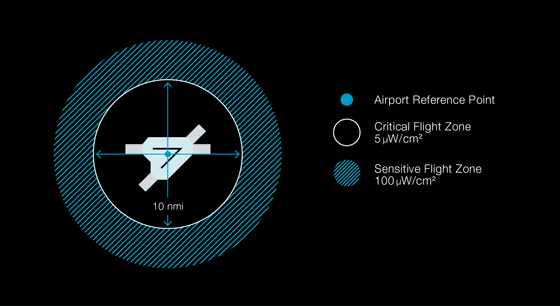
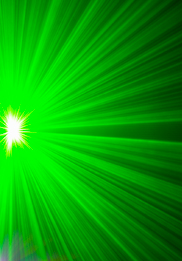
Laser illumination of commercial airplanes is a growing threat to operational safety, and the number of incidents
is increasing. The U.S. Federal Aviation Administration (FAA) laser-incident database contains more than 3,200 reports of incidents since 2004 and provides information on the locations, altitudes, color of light, and phases of flight that show the most activity. By knowing how the laser affects the eye and following recommended procedures, pilots can reduce this safety threat.
By Peter A. Derenski, Technical Fellow, Human Systems Integration
Flight crew exposure to a strong laser light source can result in flash blindness and afterimages.
A growing threat to air transportation safety involves laser pointers directed at commercial airplanes by people near flight routes and airports. Because laser light can distract flight crews and damage eyes, the commercial aviation industry needs to be aware of the threat posed by laser illumination, the protective technologies available and their effects on flight deck lighting, and the recommended defensive procedures for pilots to follow. This article describes typical laser incidents, discusses laser properties and effects on eyesight, and provides recommendations for mitigating the effects of laser illumination.
Laser illumination incidents
Lasers are a source of collimated, monochromatic, coherent light that can travel long distances with very little loss of intensity. This coherent property is what allows a laser to maintain a narrow, high-powered beam over long distances. Lasers are available in a variety of colors, intensities, and power outputs. Green lasers, which have become increasingly more affordable, have been reported in more than 90 percent of the documented laser incidents.
There was a time when the only lasers pilots needed to worry about came from Las Vegas hotels or a light show at one of the Disney properties (see fig. 1). But small laser pointers have been available to the public for quite some time, and their number is increasing as they become more affordable.
Figure 1: Professional laser light show
Until recently, the expense of lasers had limited their use to professional shows, but lower prices on handheld laser pointers have made this type of device widely available. (Photo courtesy of Dr. Leon McLin.)
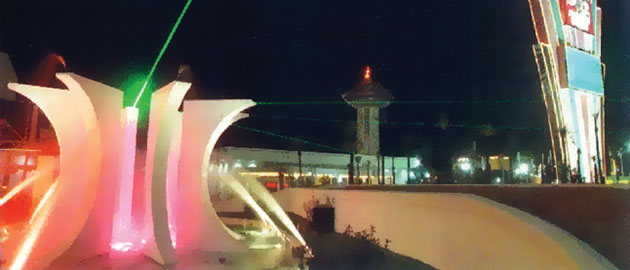
Since Advisory Circular 70-2 on Reporting of Laser Illumination of Aircraft was published by the FAA in late 2004, more than 3,200 laser incidents have been reported within the United States, along with hundreds more internationally. A laser illumination incident begins quite suddenly as the flight deck is filled with a bright light. The glare makes it difficult to concentrate on the flight instruments and can remove the crew’s visual references with the runway environment, making pilots unsure of their position relative to the runway and the ground. According to the FAA incident database, 50 percent of reported incidents occurred at 5,000 feet or below and usually during evening hours. Some incidents have been reported during cruise at much higher altitudes. The western Pacific region of the United States has had the greatest number of reports, with the highest number of incidents occurring in the San Jose and Los Angeles areas.
Under the USA PATRIOT Act, it is a federal offense to interfere with the safe operation of an airplane, and that includes the flight crews. Recently an individual was sentenced to two and a half years in prison for directing a laser at an airplane near the John Wayne Airport in Los Angeles.
Incidents are occurring not only in the United States but internationally as well. Reports of laser incidents have come from Australia, Canada, England, Germany, and Ireland. In one incident at Sydney, Australia, in March 2008, a number of people armed with lasers and cell phones performed what was described as a “coordinated attack” on landing airplanes. Some airplanes landed, others executed missed approaches, and others diverted to other airports. During this incident, air traffic controllers were forced to change the active runway to get airplanes away from the laser pointers.
The effect of laser light on eyesight
How a laser affects the eye depends on the wavelength of the laser, the power level, and the duration of the exposure. The optics of the human eye can take available light and multiply it 100,000 times, allowing people to see on dark, moonless nights. That dark adaptation can be lost in the presence of a strong light source and can take several minutes to readapt.
The human eye sensitivity peaks in the green range and perceives green 30 times brighter than red. When comparing a green and a red laser of equal power output, the green one will appear much brighter than the red.
Visible light lasers (380 to 750 nanometers) enter the optical system and are magnified and focused on the back of the eye (retina), making the retina the target of the laser energy. The eye’s natural defense for bright visible light is the blink response, which can take effect within a quarter of a second.
Nonvisible light can be in the wavelength range of ultraviolet (200 to 380 nanometers), near infrared (750 to 1,400 nanometers), or mid to far infrared (1,400 nanometers to 1 millimeter). Nonvisible lasers also enter the optical system and affect the eye, but they are not visible and present a different challenge: the blink response only works with visible light, so there is no natural protection for the eye when outside the visible spectrum. Near infrared light has the same effect on the retina as visible light, but cannot be seen. Ultraviolet and mid- to far-infrared wavelengths affect the cornea and lens and can cause corneal clouding or cataracts.
With visible light (380 to 750 nanometers), a range of effects can occur during and after a visible laser exposure. Starting from the mildest form, lasers can cause glare — an interference that inhibits the viewer from seeing details in the visual scene due to excess brightness. At lower power levels or long distances from the source, this can simply be a distraction (see fig. 2). At stronger levels or closer to the source, the high brightness can preclude a viewer from seeing outside landmarks and references and can affect pilots’ ability to clearly see an instrument panel directly in front of them (see figs. 3 and 4).
Figures 2–4: Simulations of laser light in an airplane flight deck
These photos, which were taken in a simulator during a study on the effects of laser light, demonstrate varying levels of laser intensity, from a distraction (fig. 2) to potentially disabling (figs. 3 and 4). Notice the runway lighting and the effects of the glare. This simulates a 5-milliwatt laser pointer seen from 3,000 feet away. (Photo series courtesy of Dr. Leon McLin.)
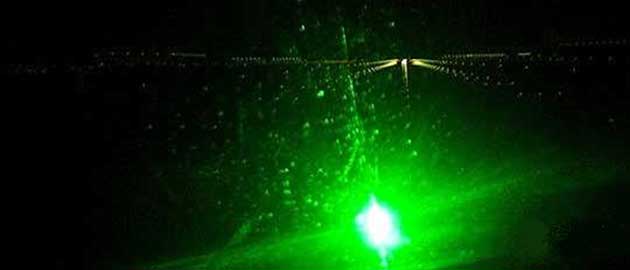
This is the effect of the same laser pointer seen from 1,000 feet away.
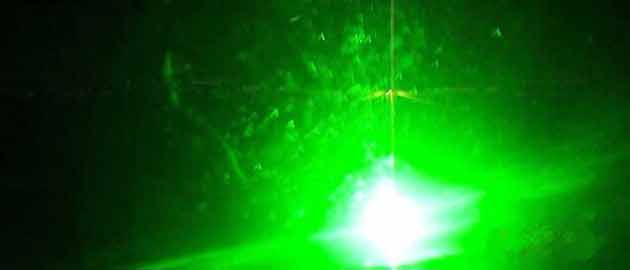
This is the effect of the same laser pointer seen from 330 feet away. Note the degraded visual cues around the runway.
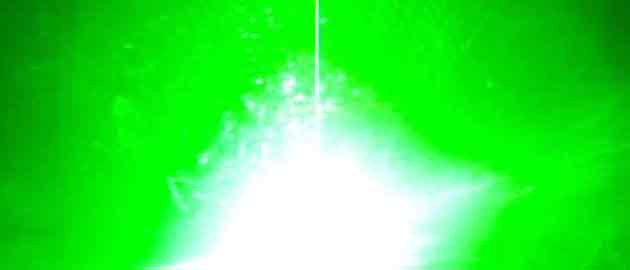
Exposure to a strong laser light source can result in flash blindness and afterimages. In flash blindness, exposure to a very bright light source can deprive pilots of vision for a period of time ranging from a few seconds to a few minutes. This can be followed by afterimages, such as the yellow and purple dots seen after a flash photo. Again, these afterimages will disappear in time.
In the most serious exposures to lasers, the lens of the eye concentrates the light energy on the retina and can actually burn the retinal tissue. The human eye can compensate for small area retinal burns by looking around them, but large area retinal burns can mean permanent loss of vision for the affected area.
Protection from visible laser lights
There are two primary ways flight crews can protect themselves from the effects of laser lights.
Protective glasses. A variety of safety glasses are available that can protect the wearer from green laser energy; however, airlines should consider the drawbacks that are associated with them. Filtering light reduces the total amount of light entering the eye, which can adversely affect normal viewing, especially at night when most laser incidents occur. In addition, filtering green light can remove some green flight symbology on flight deck displays and change the appearance of some of the other colors used. As a result, protective glasses should be used with care. Regular sunglasses do not provide any protection from lasers.
Procedural changes. Flight crews who find themselves in a situation involving laser light in the cockpit should consider taking these steps:
- Look away from the beam or shield eyes from the light.
- Execute a missed approach if the light is severe enough to warrant it.
- Engage the autopilot or transfer airplane control to the other pilot if that pilot is not affected.
- Use Autoland if available. Autoland, included on all Boeing production models, works with a ground-based instrument landing system and uses the autopilot to fly an approach all the way to roll out without the direct involvement of the pilot.
- Increase the brightness of the interior lights to reduce some of the effects of the laser and put additional light on the instrument panel.
- Inform the controlling agency and provide the approximate location of the source.
- Avoid rubbing the eyes after an exposure to laser light and seek professional medical help, if necessary. If the surface of the eye is damaged, rubbing will make it worse.
Additional information
Additional information about laser safety can be found in these publications:
- The American National Standards Institute (ANSI) publication Z 136.1: Safe Use of Lasers.
- SAE Aerospace Recommended Procedures (ARP) 5535: Observers For Laser Safety in the Navigable Airspace.
- SAE ARP 5572: Control Measures for Laser Safety in the Navigable Airspace.
- SAE ARP 5598: Laser Visual Interference: Pilot Operational Procedures.
Summary
The number of laser incidents involving commercial airplanes continues to increase every year. The best way for flight crews to protect themselves is by being aware of the problem and by following proper procedures if affected by laser light.
For more information, contact Peter Derenski.

In the United States, the Federal Aviation Administration (FAA) has established airspace zones designed around airports and other sensitive airspace that should be protected from the hazards of visible laser light exposure.
Laser-Free Zone (LFZ). Airspace in the immediate proximity of the airport, up to and including 2,000 feet above ground level (AGL), extending two nautical miles (nmi) in all directions measured from the runway centerline (see fig. A). Additionally, the LFZ includes a three-nmi extension that is 2,500 feet on each side of the extended runway centerline, up to 2,000 feet AGL of each usable runway surface. The effective irradiance of a visible laser beam is restricted to a level that should not cause any visual distraction or disruption.
Critical Flight Zone (CFZ). Airspace within a 10-nmi radius of the airport reference point, up to and including 10,000 feet AGL (see fig. B). The effective irradiance of a visible laser beam is restricted to a level that should not cause transient visual effects (e.g., glare, flash blindness, or afterimage).
Sensitive Flight Zone (SFZ). Airspace outside the critical flight zones that authorities (e.g., FAA, local departments of aviation, military) identify to be protected from the potential visual effects of laser beams (see fig. B).
Normal Flight Zones (NFZ). Airspace not defined by the laser-free, critical flight, or sensitive flight zones. As with all the zones, the NFZ must be protected from a laser beam that exceeds the maximal permissible exposure, as defined by the FAA.
Figure A: Laser-free zone
The FAA prohibits the use of any visible laser beam that can cause any visual distraction or disruption
in the immediate airport landing area.
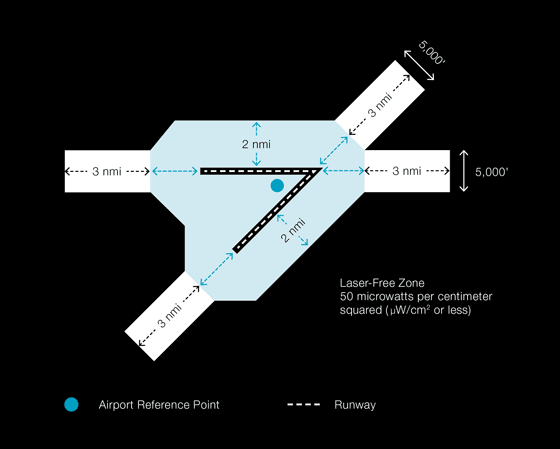
Figure B: Airspace flight zones
Critical and sensitive flight zones, as defined by the FAA.
